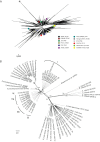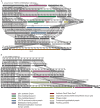Identification of Virulence-Associated Properties by Comparative Genome Analysis of Streptococcus pneumoniae, S. pseudopneumoniae, S. mitis, Three S. oralis Subspecies, and S. infantis
- PMID: 31481387
- PMCID: PMC6722419
- DOI: 10.1128/mBio.01985-19
Identification of Virulence-Associated Properties by Comparative Genome Analysis of Streptococcus pneumoniae, S. pseudopneumoniae, S. mitis, Three S. oralis Subspecies, and S. infantis
Erratum in
-
Erratum for Kilian and Tettelin, "Identification of Virulence-Associated Properties by Comparative Genome Analysis of Streptococcus pneumoniae, S. pseudopneumoniae, S. mitis, Three S. oralis Subspecies, and S. infantis".mBio. 2019 Oct 15;10(5):e02520-19. doi: 10.1128/mBio.02520-19. mBio. 2019. PMID: 31615967 Free PMC article. No abstract available.
Abstract
From a common ancestor, Streptococcus pneumoniae and Streptococcus mitis evolved in parallel into one of the most important pathogens and a mutualistic colonizer of humans, respectively. This evolutionary scenario provides a unique basis for studies of both infection-associated properties and properties important for harmonious coexistence with the host. We performed detailed comparisons of 60 genomes of S. pneumoniae, S. mitis, Streptococcus pseudopneumoniae, the three Streptococcus oralis subspecies oralis, tigurinus, and dentisani, and Streptococcus infantis Nonfunctional remnants of ancestral genes in both S. pneumoniae and in S. mitis support the evolutionary model and the concept that evolutionary changes on both sides were required to reach their present relationship to the host. Confirmed by screening of >7,500 genomes, we identified 224 genes associated with virulence. The striking difference to commensal streptococci was the diversity of regulatory mechanisms, including regulation of capsule production, a significantly larger arsenal of enzymes involved in carbohydrate hydrolysis, and proteins known to interfere with innate immune factors. The exclusive presence of the virulence factors in S. pneumoniae enhances their potential as vaccine components, as a direct impact on beneficial members of the commensal microbiota can be excluded. In addition to loss of these virulence-associated genes, adaptation of S. mitis to a mutualistic relationship with the host apparently required preservation or acquisition of 25 genes lost or absent from S. pneumoniae Successful adaptation of S. mitis and other commensal streptococci to a harmonious relationship with the host relied on genetic stability and properties facilitating life in biofilms.IMPORTANCEStreptococcus pneumoniae is one of the most important human pathogens but is closely related to Streptococcus mitis, with which humans live in harmony. The fact that the two species evolved from a common ancestor provides a unique basis for studies of both infection-associated properties and properties important for harmonious coexistence with the host. By detailed comparisons of genomes of the two species and other related streptococci, we identified 224 genes associated with virulence and 25 genes unique to the mutualistic species. The exclusive presence of the virulence factors in S. pneumoniae enhances their potential as vaccine components, as a direct impact on beneficial members of the commensal microbiota can be excluded. Successful adaptation of S. mitis and other commensal streptococci to a harmonious relationship with the host relied on genetic stability and properties facilitating life in biofilms.
Keywords: Streptococcus mitis; Streptococcus oralis; Streptococcus pneumoniae; bacteremia; commensal; evolution; infective endocarditis; mutualism; virulence.
Copyright © 2019 Kilian and Tettelin.
Figures



Similar articles
-
Capsular Polysaccharide Expression in Commensal Streptococcus Species: Genetic and Antigenic Similarities to Streptococcus pneumoniae.mBio. 2016 Nov 15;7(6):e01844-16. doi: 10.1128/mBio.01844-16. mBio. 2016. PMID: 27935839 Free PMC article.
-
Parallel evolution of Streptococcus pneumoniae and Streptococcus mitis to pathogenic and mutualistic lifestyles.mBio. 2014 Jul 22;5(4):e01490-14. doi: 10.1128/mBio.01490-14. mBio. 2014. PMID: 25053789 Free PMC article.
-
Comparative Genomic Analyses of Streptococcus pseudopneumoniae Provide Insight into Virulence and Commensalism Dynamics.PLoS One. 2013 Jun 19;8(6):e65670. doi: 10.1371/journal.pone.0065670. Print 2013. PLoS One. 2013. PMID: 23840352 Free PMC article.
-
Versatility of choline metabolism and choline-binding proteins in Streptococcus pneumoniae and commensal streptococci.FEMS Microbiol Rev. 2009 May;33(3):572-86. doi: 10.1111/j.1574-6976.2009.00172.x. FEMS Microbiol Rev. 2009. PMID: 19396958 Review.
-
The novel species Streptococcus tigurinus and its association with oral infection.Virulence. 2015;6(3):177-82. doi: 10.4161/21505594.2014.970472. Epub 2014 Nov 17. Virulence. 2015. PMID: 25483862 Free PMC article. Review.
Cited by
-
Trial Proteomic Qualitative and Quantitative Analysis of the Protein Matrix of Submandibular Sialoliths.Molecules. 2021 Nov 6;26(21):6725. doi: 10.3390/molecules26216725. Molecules. 2021. PMID: 34771131 Free PMC article.
-
Serotype-Switch Variant of Multidrug-Resistant Streptococcus pneumoniae Sequence Type 271.Emerg Infect Dis. 2021 Jun;27(6):1689-1692. doi: 10.3201/eid2706.203629. Epub 2021 Apr 29. Emerg Infect Dis. 2021. PMID: 33915076 Free PMC article.
-
Site-tropism of streptococci in the oral microbiome.Mol Oral Microbiol. 2022 Dec;37(6):229-243. doi: 10.1111/omi.12387. Epub 2022 Oct 11. Mol Oral Microbiol. 2022. PMID: 36073311 Free PMC article.
-
Comparative analysis of Streptococcus suis genomes identifies novel candidate virulence-associated genes in North American isolates.Vet Res. 2022 Mar 18;53(1):23. doi: 10.1186/s13567-022-01039-8. Vet Res. 2022. PMID: 35303917 Free PMC article.
-
Human Serum Supplementation Promotes Streptococcus mitis Growth and Induces Specific Transcriptomic Responses.Microbiol Spectr. 2023 Jun 15;11(3):e0512922. doi: 10.1128/spectrum.05129-22. Epub 2023 Apr 4. Microbiol Spectr. 2023. PMID: 37014220 Free PMC article.
References
-
- Jensen A, Scholz CF, Kilian M. 2016. Re-evaluation of the taxonomy of the Mitis group of the genus Streptococcus based on whole genome phylogenetic analyses, and proposed reclassification of Streptococcus dentisani as Streptococcus oralis subsp. dentisani comb. nov., Streptococcus tigurinus as Streptococcus oralis subsp. tigurinus comb. nov., and Streptococcus oligofermentans as a later synonym of Streptococcus cristatus. Int J Syst Evol Microbiol 66:4803–4820. doi:10.1099/ijsem.0.001433. - DOI - PubMed
Publication types
MeSH terms
Substances
Supplementary concepts
LinkOut - more resources
Full Text Sources
Molecular Biology Databases
